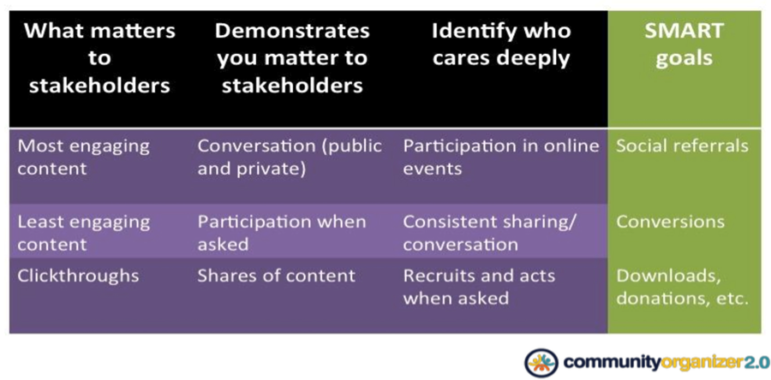
At NTEN’s 2017 Nonprofit Technology Conference, Debra Askanase, founder and digital engagement strategist at Community Organizer 2.0, held an informative session on advanced social media practices. The session took social media management to the next level, focusing on what metrics nonprofits should be focusing in on to help make decisions around online engagement.
Three important questions that can help guide your organization in what data should be valuable to track:
- Does it inform our decisions?
- Does it check our progress?
- Does it show if we matter?
At NTC17, Debra provided a useful table, shown below, to further understand which metrics matter most to stakeholders as contrasted with SMART goals (Specific, Measurable, Attainable, Realistic and Time-based) nonprofits should consistently be measuring:

Reach, for example, is a common metric on social media, specifically on Facebook, but one that’s less important to track and could be almost considered a vanity metric. Can you trust that 800 individuals saw your post? Did each of those users actually view your content, or were they concentrating on something else, perhaps using Facebook Messenger or scrolling down their newsfeed without digesting half of the posts they passed? Usually, if your reach is increasing, it’s mainly because engagement with that post is growing. Therefore engagement is a more significant metric that can help you better understand why you expanded your reach.
There are a plethora of ways to track social media metrics, from Twitter and Facebook Insights, to third-party platforms like Hootsuite and Buffer that can gather all your social data together, to web analytics that can help you parse from which social channels your online users are coming. One useful approach to keeping all the traffic metrics you want to track in one place is to create a Google Analytics dashboard for social media.
The social management tools your organization chooses should let you do each of the following:
Sign up for our free newsletters
Subscribe to NPQ's newsletters to have our top stories delivered directly to your inbox.
By signing up, you agree to our privacy policy and terms of use, and to receive messages from NPQ and our partners.
- Post content to multiple social media channels and networks
- See your scheduled social media at a glance
- Create links that you can track
- Find successful content (based on engagement or clicks)
- See interactions and respond
- Search for keywords, hashtags and conversations
- Find your community
- Coordinate responses from your team
- Measure impact
Social Campaigns
When planning to launch a social media campaign, an organization should keep a few things in mind. Are you incorporating storytelling elements in your online campaign? Are you connecting emotionally to your audience? Is the campaign connected to a larger cause? All of these questions are very important in establishing a successful campaign.
A cohesive design is also extremely important, ensuring that the online campaign is simple for users to participate in, to share with their networks, and easy to follow is essential. If your audience isn’t aware of the specific ask, your campaign will not succeed.
Here are some reasons online campaigns can and will often fail. Look over this list carefully to ensure your organization is not starting out on the wrong foot:
- Unrealistic goals
- Not enough time to develop campaign
- Not where your people are
- Not having the right measurement system in place, or not able to measure success
- Undeveloped social spaces at the start
- Did not involve engaged social media fans ahead of the campaign
Why and When to Use Advertising
On platforms like Facebook and Twitter, spending a little advertising money here and there on sponsored posts can go a long way. Just spending ten or twenty dollars on a few Facebook ads can be valuable in gaining data and insights on how to further engage with your online community.
Here are a few tools offered in Facebook Advertising worth playing around with:
- Lookalike Audiences: Creating a lookalike audience is a great way to reach new people who are likely to be interested in your mission and the content you’re offering. Once you select a source audience in Facebook based on a group you have targeted in the past, Facebook will then identify a new group of users that share common interests and behaviors of the source audience provided. You can select the size of your lookalike audience, and it’s suggested you start out small so the target group will reflect your source audience more accurately.
- Retargeting: No one will engage with your content better than someone who already knows and is connected with your nonprofit. By using Facebook pixels on your website, you can retarget Facebook users that have already interacted with your site to try to hit them up for additional actions, from joining mailing lists to asking for donations. Once you start retargeting through ads, you can even go one step further by including a conversion pixel on certain pages that will allow you to track when a goal is reached based on someone taking action from your ad.
During 17NTC’s Advances Social Media Practices session, Debra shared seven golden rules in social advertising:
- Know what you want to learn.
- Identify your audience.
- Create multiple versions of the same ad.
- Don’t make the ask too much.
- Create a custom landing page for ads.
- Keep the time period brief (test, learn, rerun the ad).
- Offer value.
So before you decide to jump on the next up-and-coming social network or start a brand new social campaign, make sure you know what your organization should measure and what your SMART goals are. A recent survey in the UK revealed that 35 percent of nonprofits use digital technologies, but don’t have any strategic approach. Are you aware of your strategic approach when it comes to social media?













